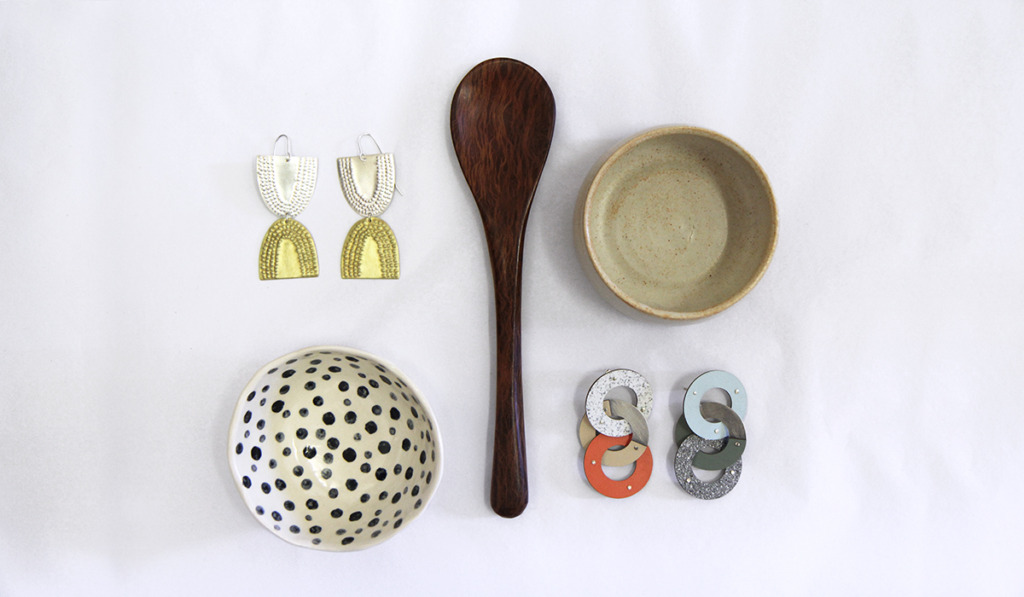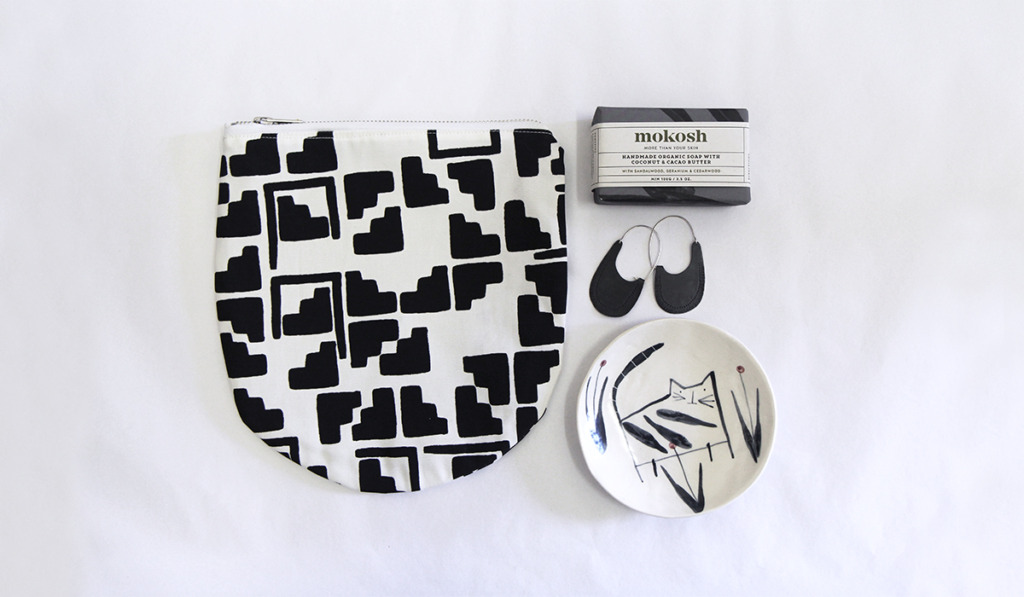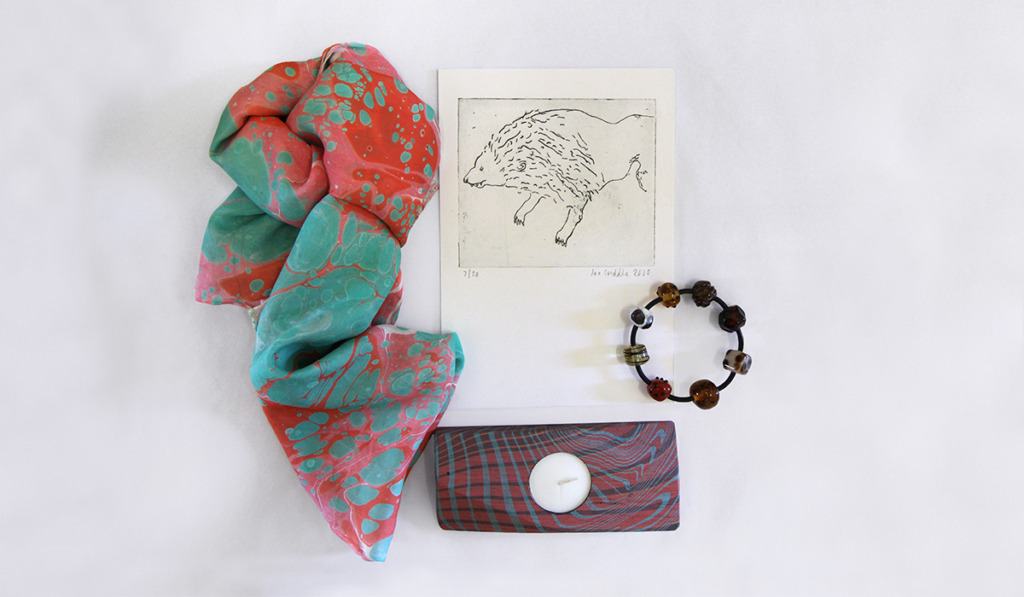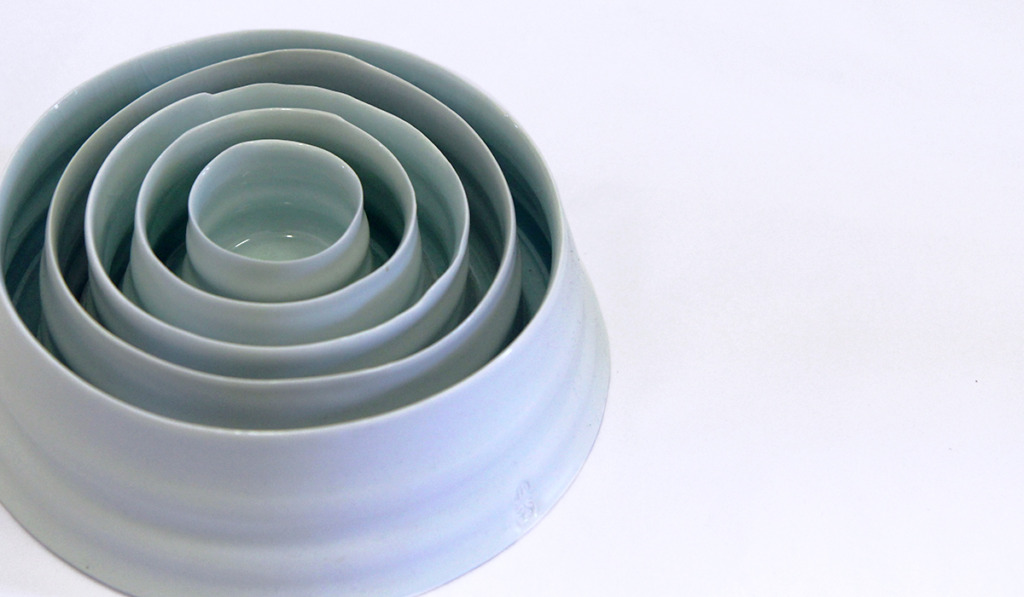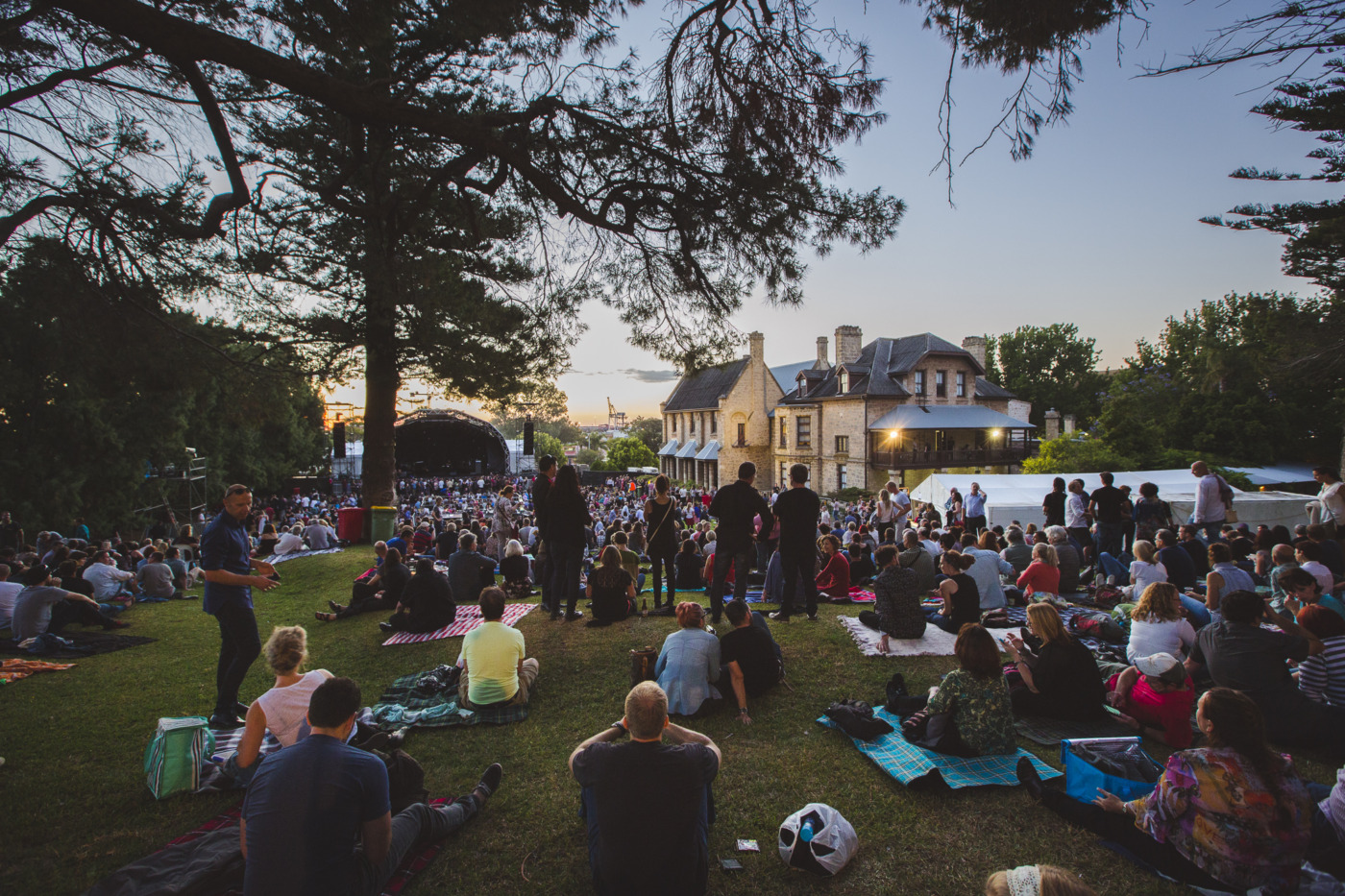FAC’s exhibition Frank Norton: Painter and Collector celebrates the life of one of WA’s most influential art figures. Frank Norton was the first Official War Artist for the Royal Australian Navy and the Director of the Art Gallery of WA for 18 years (1958–1976), overseeing the development of a new home for the gallery and remaining a prolific artist in his own right.
Available alongside the exhibition is a book written by City of Fremantle Art Collector Curator André Lipscombe detailing Norton’s career and his enduring contribution to the WA art scene. Exhibition runs until Sunday 22 January.

Frank Norton, Fremantle from East Street, 1963, oil paint on board, City of Fremantle Art Collection
Frank Norton: Painter and Collector [extract]
From the Foreword
Dad was a kind, loving, caring father with a Christian faith, a broad knowledge of life, a sense of humour, a love of musicals, and a strong compassion for Aboriginal people and their art.
Sketchbook and pipe were his constant companions, with his eyes, mind and hand his instruments – he had no need for a camera. Even though the majority of his latter artwork was of the land, his heart was still with the sea.
On behalf of my sisters, Janice and Robyn.
Lynne Norton
Painting Fremantle
Norton was familiar with Fremantle and its harbour well before returning to Perth for the Gallery posting in 1958. He had entered the Swan estuary and the port on numerous occasions both during peace time and while on active service. Fremantle was the last port of embarkation for Australian troops heading to war and the point at which returning vessels made landfall in Australia.
During the first months of his appointment as a War Artist, Norton travelled aboard HMAS Brisbane, HMAS Sydney and numbers of escort and convoy vessels. Prior to his time with the Mediterranean Eastern Fleet he recorded HMAS Sydney berthed at Fremantle sporting her grey disruptive camouflage design in July 1941.
In July 1942, at the height of the success of Japanese forces north of Australia, he would be stationed at HMAS Leeuwin barracks in Fremantle.
From this staging point Norton documented Allied warships preparing for the defence of Western Australia. He produced drawings and oil sketches at Fremantle of RAN and Allied ships including submarine fleets and Corvettes, and also wooden ship building yards. It was at this station that he produced his first Fremantle slipway pictures and detailed studies of defensive gun emplacements at South Mole and Swanbourne. Further afield he produced studies of US Navy Patrol Wing Number 10, a Catalina Squadron based at Crawley Bay in Perth and RAAF 25 Squadron at Pearce Airbase.
On his return to Perth after the War Norton briefly returned to working directly from familiar subjects, producing sketches and paintings of landscapes at Fremantle Harbour, including slipways and South Mole, which he had painted fifteen years previously. He completed a number of drawings and at least two oil sketches of ships in dry-dock. These studies would ultimately lead to a more substantive and imaginative studio picture, an elevated view from South Mole Head Lighthouse looking east. Fremantle Harbour 1959 was the first major work painted in his office studio and exhibited at The Society of Artist’s Spring Exhibition at Blaxland Gallery, Sydney and subsequently acquired by the AGNSW in 1960.
Future commissions of Fremantle subjects were forthcoming and included a City of Fremantle presentation picture Port of Fremantle 1964, gifted to Parliament House Perth as well as a picture titled Fremantle 1969, presented in recognition of the appointment of the first honorary Fremantle Freeman Sir Frederick Samson in 1969.[1]
[1] Sir Frederick Samson was the Mayor of City of Fremantle 1951–1972.
This is an extract from Frank Norton: Painter and Collector by City of Fremantle Art Collector Curator André Lipscombe available for purchase from Fremantle Arts Centre.
Exhibition runs until Sunday 22 January.
Find out what’s on at Fremantle Arts Centre this summer in our complete digital guide.
Our shop FOUND at Fremantle Arts Centre is brimming with beautiful, unique gifts for that last-minute Christmas shop. Filled with the largest range of locally made wares in WA, FOUND stocks jewellery, textiles, woodwork, ceramics, toys, beauty products, prints, books and more.
We’ve put together a Christmas gift guide to inspire those final presents for loved ones. FOUND is open 9am–5pm daily this holiday season.
Sterling silver & brass earrings by Julie Holmes $185
Sheoak spoon by Tony Docherty $35
Spotty porcelain bowl by Anthea Carboni $15
Karri series bowl by Stewart Scambler $20
Sterling silver & laminex earrings by Rose Megirian $280
Screenprinted cotton clutch by Ruby Talbot Dunn $55
Handmade organic soap by Mokosh $12
Oxidised copper earrings by Julie Holmes $165
Porcelain animal dish by Anthea Carboni $26
Marbled silk scarf by Vesile Yilmaz $150
Lion etching by Jae Criddle $55
Marbled jarrah candle holder by Sarmarie Higgins $35
Glass beaded bracelet by Evelyn Henschke $95
Porcelain nesting bowls by Sandra Black $450
Fremantle Arts Centre and Art Ichol (India) are pleased to announce a new partnership that will see Western Australian and Indian artists engage in an Artist in Residence Exchange Program. FAC will select one WA artist to travel to the rural city of Maihar in Madhya Pradesh, India to live and work at Art Ichol during September 2017.
Art Ichol is a multi-faceted arts organisation that hosts national and international artists in a diverse artist in residence program. Consisting of three estates, The Art Ichol Skill Centre, The Maihar Heritage Home and Amaria ~ The Writer’s Retreat, Art Ichol offers a unique living and working experience. Art Ichol’s facilities include studio spaces, living quarters, an art gallery, bronze casting foundry, open-air sculpture park, stone and wood carving workshop, ceramic and pottery centre, painter’s studio, clay modelling room, graphic studio and an art café.
“We’re thrilled to be partnering with Art Ichol, an organisation that’s known for its’ innovative residency program and strong creative culture. The Artist in Residence Exchange Program offers artists an opportunity to develop their practice, explore a part of Indian culture and use studios and facilities that they might not have access to otherwise,” said FAC Director Jim Cathcart.
Applications for the 2017 Fremantle Arts Centre & Art Ichol Artist in Residence Exchange Program are now open and FAC invites WA artists to apply.
The successful applicant will receive a return airfare between Perth and India (including airport transfers from the Indian airport), independent living quarters, three meals a day, laundry and WiFi facilities, an independent workspace (including a quantified supply of working materials) and access to Art Ichol’s shared workshops and studios.
Only artists whose primary place of residence and work is located within WA are eligible to apply. Applications close COB Friday 24 February 2017.
For more information about Art Ichol Maihar visit http://artichol.in/ArtIchol.html
For further details about the 2017 Fremantle Arts Centre & Art Ichol AIR Exchange Program or to apply, contact FAC AIR Coordinator Bevan Honey at bevanh@fremantle.wa.gov.au.
Applications must be made to Fremantle Arts Centre.
For media enquiries contact Communications Assistant Sam Leung at saml@fremantle.wa.gov.au or 08 9432 9565.
Opening Fri 17 Nov | 6:30pm | Free | Exhibition Runs Sat 18 Nov 2017 – Sun 21 Jan 2018
In Cahoots: artists collaborate across Country is a major new creative project which sees artists from six Aboriginal art centres partnered with leading independent artists from around the country to produce significant new collaborative works through a series of artist residencies.
Presented by FAC, the project will culminate in an exhibition in November 2017 which explores the exciting and challenging nature of collaboration between art centres and both Aboriginal and non-Aboriginal artists.
In Cahoots is led by the Aboriginal art centres at every stage of the project, from selecting the visiting artists and planning the exhibition, to engaging directly with audiences.
Participating art centres and artists include:
- Baluk Arts (VIC) with Neil Aldum (WA)
- Buku-Larrnggay Mulka Arts Centre (NT) with Curtis Taylor (WA)
- Mangkaja Arts (WA) with Trent Jansen (NSW)
- Martumili Artists (WA) with Claire Healy & Sean Cordeiro (NSW)
- Papulankutja Artists (WA) with Louise Haselton (SA)
- Warakurna Artists (WA) with Tony Albert (QLD)
Perth-based Martu artist Curtis Taylor will collaborate with Yolngu artist Ishmael Marika from Buku-Larrnggay Mulka Arts Centre (NT), to construct a haunting installation that combines carved wooden poles and video components. With a shared background in film, the artists will draw on Australian cult cinema and Martu and Yolngu culture.
Martumili Artists (WA), based in Newman, and internationally renowned artists Claire Healy and Sean Cordeiro (NSW) will work with raw and found materials to create a large-scale installation. Healy and Cordeiro represented Australia in the 53rd Venice Biennale (2009) and are known for their inventive works, often dismantling or assembling large objects through a process of epic transformation, including once pulling apart an entire aircraft and binding it with string.
In a meeting of supremely skilled object makers, Mangkaja Art Centre (WA) has invited Sydney designer Trent Jansen to share stories and exchange skills while crafting works from wood, bone, stone, leather and fabricated materials. Jansen is known for his richly symbolic objects that draw on the identities of individuals, families and communities. He will work with John Prince Siddon, a talented Walmajarri artist and senior Gooniyandi artists Mervyn Street and Tommy May.
Papulankutja Artists (WA) is known for their innovative fibre works and production of local bush products. Inspired by the startling materiality of her work, Papulankutja Artists has chosen to collaborate with Louise Haselton (SA) whose fascinating sculptures and installations offer a playful examination of an object’s intrinsic material properties.
Tony Albert (QLD) is a descendent of the Girramay, Yidinji and Kuku-Yalanji people, whose work explores Aboriginal and Australian history, often incorporating elements of kitsch ‘Aboriginalia’. Warakurna Artists (WA), a key organisation in the Western Desert Mob alliance, have invited Albert to learn about their creative practices and form a new collaborative body of work.
Baluk Arts (VIC) is based in the Mornington Peninsula and represents Aboriginal artists from across Australia, many of who are members of the stolen generation. The arts centre will work with Neil Aldum, a Perth-based artist known for combining unexpected skills in his artworks, including woodwork and sewing.
In Cahoots is curated by FAC Special Projects Coordinator Erin Coates and supported by the WA Department of Culture and the Arts through its Future Focus initiative.
For media enquiries contact Communications Assistant Sam Leung at saml@fremantle.wa.gov.au or 08 9432 9565.
Fremantle Arts Centre Artist in Residence Manabu Kanai (JPN) enjoys a challenge. The adventurous artist has exhibited across the globe, including Melbourne, Japan and Slovakia and has a PhD from Tokyo University of the Arts (2015).
Manabu’s decision to abandon traditional art forms, from painting, sculpture and installation, stem from an interest in creating site-specific work where the site itself becomes an integral part of the piece.
“Often a white cube is considered the best space to show artwork in the art world – a neutral space. For me, the noise of the white cube’s doors and windows are something I try to emphasise. I base my work on the space itself where the space becomes both a material and part of the form the work takes,” Manabu says.

Manabu Kanai (JPN), Parataxis, Everyday Life (detail), 2016, stone, MDF, perspex, acrylic paint, dimensions variable
The bilingual artist’s practice centres around his desire to escape the bounds of language and his quest to create a new visual form of expression.
In his Fremantle Arts Centre exhibition Parataxis, Everyday Life, Manabu uses stones found on North Fremantle’s beaches, repositioning these in a gallery space and reflecting on the qualities the stones assume in their newfound home.
“The way we perceive the world is locked in a prison of our language. I’m interested in the genesis of language and how our thoughts and knowledge of the world is dictated by the words we know and use,” Manabu says.
“I try to surpass this, designing a visual language where there is no meaning or message behind my work but something transcendental.”
Parataxis, Everyday Life opens on Sunday 6 November from 3–5pm. The exhibition will run from 10am–5pm daily from Monday 7 – Wednesday 16 November. Manabu will be available to give tours of the show and discuss his work by appointment. Email manabukanai@terrainvague.info to arrange a time.

Manabu Kanai (JPN), Parataxis, Everyday Life (detail), 2016, stone, MDF, perspex, acrylic paint, dimensions variable
Ever wandered through a familiar environment and discovered something completely new? Artist in Residence Elyssa Sykes-Smith (NSW) plays with our perception and response to spaces through her Mind Walks series. These meditative, sightless journeys see the artist guide blindfolded participants through Fremantle, encouraging people to explore places purely through touch, sound and smell.
Last week I went on my own Mind Walk. Elyssa blindfolded me, and we left her FAC studio wearing matching Mind Walker shirts and name tags. Linked at the arm for obvious reasons, we walked into the centre of Fremantle.

As a Freo local, it was a strangely familiar yet foreign experience. Being unable to see, textures, sounds and smells became heightened. Walking past construction sites, busy cafes and Asian restaurants, the first thing I would notice was a sudden rich smell of delicious food or the din of rackety machines. Time is hard to keep track of without your eyes. They constantly remind us of where we’ve been and where we’re going. Rather than finding this loss of bearing daunting, it was quite relaxing, not having anywhere to be or worrying about where I might be headed.

Eventually we reached Elyssa’s site for the day. She led me to the edge of the place and left me to explore. I moved forward warily along the wall, making sure not to run head first into some hard, unknown object. The surface here was rough and dusty with a pattern of vertical grooves. It was filled with angles and strange, dull feeling windows – I assumed they were windows. I turned a corner and the atmosphere shifted. The slight colour and light I could catch through my eye lids and blindfold dropped straight into blackness. It was far colder here and rather eerie. I walked past what felt like parked cars, cars feel odd and bulbous when you can’t see them. The place itself felt mysterious and constantly shifting. At one point it felt like I’d step into a completely different building (I was very suspicious it was a public toilet block – it wasn’t).


We headed back to Elyssa’s studio. I sat in a chair and tried to recall the whole experience, the murky layout of the building and its’ many grooves and ridges. Elyssa asked a series of probing questions, drawing constantly as I spoke. We discussed how I had felt exploring the space, and what sort of space I thought it was. Very cavernous. Elyssa’s studio is covered with these sensory, memory drawings. It’s a beautiful light-filled space, definitely worth a visit.

If you’d like to take a Mind Walk get in touch with Elyssa at elyssasykessmith@gmail.com. The full series of works will be exhibited at the Moores Building Contemporary Art Gallery from Saturday 17 September – Sunday 2 October in Mind Walk: Portrait of Fremantle.
This week we spoke to Kate Weedon-Jones, a much-loved tutor in our art courses program and long-term employee in the FOUND Shop. Kate’s been working in textiles for almost 40 years and has been involved with FAC since the early 1980s. Here she shares the story behind her textile practice and how she first discovered the technique of shibori.
Tell us a bit about yourself and your practice. How long have you been making work and what do you create?
My textile practice has spanned nearly 40 years now. Having grown up in a design-oriented family – my father was an architect and my mother an artist and textile enthusiast/weaver extraordinaire (my brother’s a doctor….we forgive him) – it was their influence in the world of art and design that fuelled my passion for fabric design from an early age. The mentorship, support and encouragement I received from my parents, pivotal senior arts educators, managers and colleagues is probably what shaped me, in my life and work.
I completed a BA in Design with a Textile Major in 1978 at WAIT (now Curtin University) and was invited to stay on in 1979 as a Graduate in Residence, which included some teaching roles, studio use and an exhibition.
The following eight years until 1986 were a full-on period of development in my work practice. I produced a wide range of textiles for exhibitions, fashion parades, retail sales and commissions. It was a great time in my life. It is true, the more you just get on with it and work hard the more opportunities come your way – it was that kind of snowball effect for me.
I also ran a specialist textile retail shop called Indigo 119 with my mother during the early to mid-80s, which stocked my work.
The main textile techniques I worked in then included dyeing, batik, weaving, screen-printing, applique and stitch. All the processes were hand done, and I still like the slow-fibre handmade approach today. It can be a meditative process.
I have had numerous part-time lecturing positions in textile design at tertiary institutions, workshops and tutoring in community programs, including the art classes at Fremantle Arts Centre, throughout my 40 year career and still enjoy the interaction and sharing of knowledge.

Kate Weedon-Jones’ shibori wool scarves
You’re also part of the FAC team, tutoring textile classes and working at FOUND. How did you first get involved with FAC?
I officially started at Fremantle Arts Centre in my early 20s in 1982, under the Directorship of Ian Templeman. I was given a position called Senior Fellow in Printed Textiles. I continued on as the resident textile designer/printer in the textile studio until early 1986.
I had a solo exhibition in the main gallery of FAC at the end of 1983, which was a very memorable experience for me.
Through the end of the 80s until early 2000 I was committed to raising my family so my textile practice took a back seat, but I continued with some production and exhibition work and part-time teaching throughout my children’s school years.
It was then that I discovered the technique of shibori resist and was very fortunate to attend the World Shibori Symposium in Santiago, Chile in 1999. I have continued working in and teaching shibori and dyeing. I find this technique absolutely fascinating and I am particularly interested in exploring the use of combined textile techniques (e.g. shibori and dye and print) in my work.
What else are you working on at the moment?
I currently work in the lovely Fremantle Arts Centre shop FOUND, having been here for nearly 12 years. I supply some of my textile shibori pieces to FOUND and I am also tutoring in FAC’s art courses program in shibori and a batik class as well. Lots of fun!
What’s up next?
For me… there’ll be more exploration of techniques to come in the next year and hopefully a website, maybe an online shop and an exhibition soon!!
My first grandchild is due very soon so maybe everything will change then!
Kate’s one-off shibori wool scarves are currently in store at FOUND. Open daily 9am–5pm


